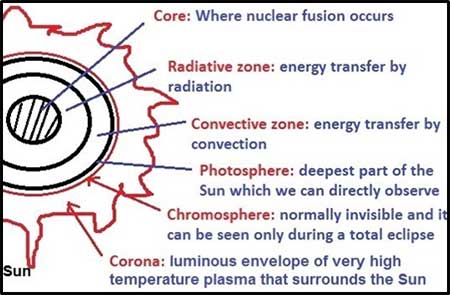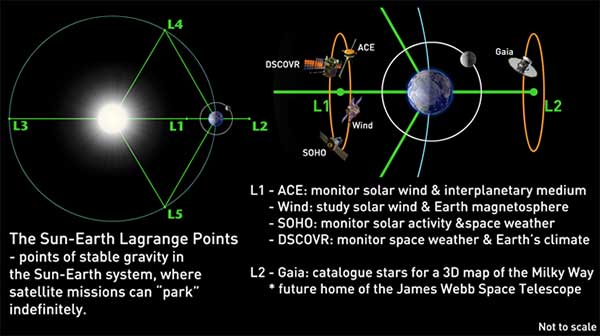Date : 05/09/2023
Relevance: GS Paper 3- Science and Technology - Space Technology
Keywords: Aditya L1, Lagrange point L1, Coronal Mass Ejections (CMEs), Solar Wind, Space weather forecasting
Context-
- In the wake of the successful soft landing of Chandrayaan 3 near the south pole, the Indian Space Research Organisation (ISRO) marked another triumph on September 2, 2023, with the launch of its inaugural solar mission, Aditya L1.
- Aditya L1 embarks on an extraordinary odyssey, spanning a staggering 1.5 million kilometers. Its ultimate destination is Lagrange point 1 (L1), a peculiar location in space where the gravitational forces of Earth and the Sun are exquisitely balanced. This equilibrium allows a spacecraft to maintain a stationary position with minimal fuel consumption.
Global Solar Missions at L1:
- Lagrange point 1, or L1, provides an unobstructed and uninterrupted view of the Sun, free from the interferences of eclipses or occultations. Notably, several renowned space agencies, including the United States, Russia, Europe, China, and Japan, have previously achieved success by launching solar missions positioned at this strategic point in space.

Aditya L1's Payloads and Goal
- Aditya L1 is equipped with a sophisticated array of seven payloads. These advanced instruments are meticulously designed to scrutinize various layers of the Sun, encompassing the photosphere (the Sun's surface), chromosphere (a thin plasma layer between the photosphere and the corona), and the outermost layers. These comprehensive observations are facilitated by cutting-edge electromagnetic particle and magnetic field detectors.


- ASPEX: Will study the variation, distribution, and spectral
characteristics of solar wind
WHY: Solar wind can affect our power lines, communication satellites and high-altitude spacecraft
- VELC: Will study the parameters of the solar corona and the
origin of Coronal Mass Ejections (CMEs)
WHY: CMEs can collide with Earth's magnetic field and change its shape
- SUIT: Will image the photosphere and chromosphere in the UV
range
WHY: A better understanding can help us keep track of solar flares emanating from the photosphere
- SoLEXS: Will monitor X-ray flares to study the heating
mechanism of the corona
WHY: Energy from X-ray flares can disrupt radio waves, causing blackouts in navigation and communications signals
- PAPA: Will study the composition of solar wind and its energy
distribution
WHY: Solar wind can disrupt communication and navigation satellites
- HEL1OS: Will observe the dynamic events in the corona and
estimate the energy used to accelerate the particles during the eruptive
events
WHY: An estimate of the energy can help us shield ourselves in an effective and timely manner
- The primary mission objectives of Aditya L1 are extensive and include a comprehensive study of a wide range of solar phenomena. This encompasses the investigation of coronal heating, the dynamics of space weather, and the intricate processes related to coronal mass ejections (CMEs). Moreover, the mission extends its scientific gaze to monitor the ever-changing environmental conditions in space, not only around Earth but also around other celestial bodies in our solar system.
Coronal Mass Ejections (CMEs)
- Coronal Mass Ejections (CMEs) are large expulsions of plasma and magnetic fields from the Sun’s corona. They can eject billions of tons of coronal material and carry an embedded magnetic field (frozen in flux) that is stronger than the background solar wind interplanetary magnetic field (IMF) strength.
- CMEs are capable of reaching and colliding with Earth's magnetosphere, where they can cause geomagnetic storms, aurorae, and in rare cases damage to electrical power grids.
Solar Wind
- The solar wind is created by the outward expansion of plasma (a collection of charged particles) from the Sun's corona (outermost atmosphere).
Solar Wind vs. Coronal Mass Ejections (CMEs)
- A CME contains particle radiation (mostly protons and electrons) and powerful magnetic fields stronger than what is normally present in the solar wind.
The Significance of India's Aditya L1 Mission in India's Journey
- Advancing Solar Physics: The Aditya L1 mission marks a pivotal step in advancing our knowledge of solar physics. The comprehensive data collected by its instrument suite promises to deepen our understanding of the Sun's dynamic activity.
- Enhanced Space Weather Forecasting: A more profound comprehension of the Sun's behavior is crucial for space weather forecasting. Solar events like flares and coronal mass ejections have the potential to disrupt communication and navigation systems. Therefore, Aditya L1 contributes to better preparedness in this regard.
- Predicting Sunspot Cycles and Energy Harvesting: Through improved prediction of sunspot cycles, Aditya L1 aids in estimating the Sun's energy output. This knowledge can play a pivotal role in harnessing renewable energy sources to meet our growing energy demands.
- Climate Change Mitigation and Adaptation: Understanding the Sun's influence on Earth's climate is essential for developing effective strategies to mitigate and adapt to climate change. India's contribution to this field aligns with its vision of being a global leader (Vishwaguru).
- Enhanced Space Exploration Capabilities: By achieving breakthroughs in solar science, India strengthens its capabilities in space exploration. This positions the nation to collaborate with international space agencies on deep space missions.
- Economic Growth and Technological Advancements: The Aditya L1 mission contributes to economic growth by fostering innovation in heat-resistant materials and enhancing space-related applications. It supports advancements in weather forecasting, navigation services, and more.
- A Catalyst for Future Space Endeavors: The success of Aditya L1 instills confidence in pursuing further solar explorations. This accomplishment not only elevates India's standing in the global space industry but also creates job opportunities and encourages private-sector partnerships.
Challenges in Solar Mission
Technological Challenges:
- Solar Panel Efficiency: Developing solar panels with higher efficiency is an ongoing challenge. More efficient panels can capture more energy from the sun, making missions more productive.
- Energy Storage: Efficient and reliable energy storage solutions are essential for missions that operate in regions with intermittent sunlight.
- Spacecraft Design: Creating spacecraft that can withstand the extreme conditions of space, including temperature fluctuations, radiation, and micrometeoroid impacts, is a significant technological challenge.
Resource Constraints:
- Budget: Adequate funding is crucial for any solar mission. There are continuous discussions about whether is India in a position to spend 400 cr. on solar missions while India is home to the world's largest poor population in the world?
- Material Resources: Access to rare or specialized materials for solar panels, spacecraft components, and energy storage systems can be limited and expensive.
Conclusion
India's Aditya L1 mission represents a significant leap in solar exploration, offering insights into solar physics, space weather forecasting, and climate change mitigation. Its advanced payloads aim to unravel the mysteries of the Sun, enhancing our preparedness for solar disruptions. Furthermore, the mission positions India as a global space player, fostering technological innovation and economic growth. Aditya L1's success serves as a catalyst for future solar endeavors, bolstering our confidence in pursuing further celestial frontiers and forging partnerships with the private sector.
Probable Questions for UPSC Mains Exam-
- Describe the scientific objectives and significance of India's Aditya L1 mission in the context of solar physics and its potential impact on space weather forecasting and climate change mitigation. (10 Marks,150 Words)
- Explain the role of Lagrange point 1 (L1) in solar missions and how Aditya L1's payload instruments contribute to our understanding of the Sun's behavior. Discuss the importance of Aditya L1 in enhancing India's space exploration capabilities and its potential economic implications. (15 Marks, 250 Words)
Source- The Hindu, Down To Earth







